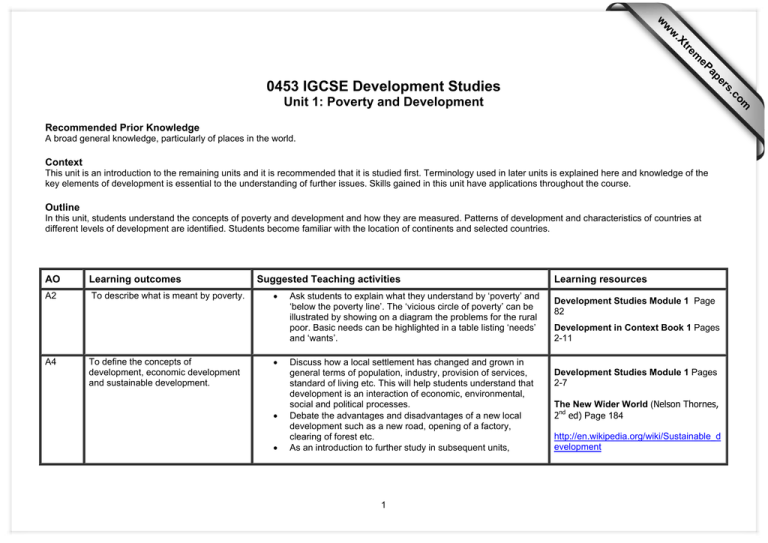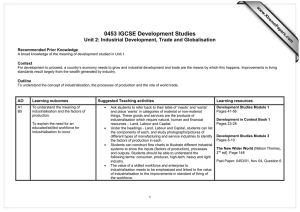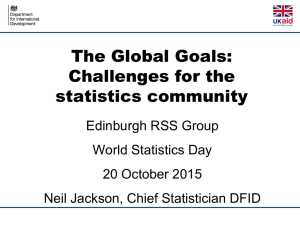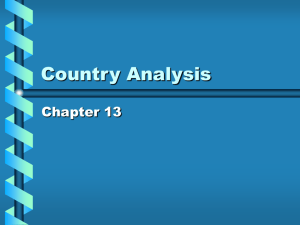0453 IGCSE Development Studies Unit 1: Poverty and Development www.XtremePapers.com
advertisement

s er ap eP m e tr .X w w w om .c 0453 IGCSE Development Studies Unit 1: Poverty and Development Recommended Prior Knowledge A broad general knowledge, particularly of places in the world. Context This unit is an introduction to the remaining units and it is recommended that it is studied first. Terminology used in later units is explained here and knowledge of the key elements of development is essential to the understanding of further issues. Skills gained in this unit have applications throughout the course. Outline In this unit, students understand the concepts of poverty and development and how they are measured. Patterns of development and characteristics of countries at different levels of development are identified. Students become familiar with the location of continents and selected countries. AO Learning outcomes A2 To describe what is meant by poverty. A4 To define the concepts of development, economic development and sustainable development. Suggested Teaching activities • • • • Ask students to explain what they understand by ‘poverty’ and ‘below the poverty line’. The ‘vicious circle of poverty’ can be illustrated by showing on a diagram the problems for the rural poor. Basic needs can be highlighted in a table listing ‘needs’ and ‘wants’. Discuss how a local settlement has changed and grown in general terms of population, industry, provision of services, standard of living etc. This will help students understand that development is an interaction of economic, environmental, social and political processes. Debate the advantages and disadvantages of a new local development such as a new road, opening of a factory, clearing of forest etc. As an introduction to further study in subsequent units, 1 Learning resources Development Studies Module 1 Page 82 Development in Context Book 1 Pages 2-11 Development Studies Module 1 Pages 2-7 The New Wider World (Nelson Thornes, 2nd ed) Page 184 http://en.wikipedia.org/wiki/Sustainable_d evelopment AO Learning outcomes Suggested Teaching activities • A3 A2 To understand the Millennium Development Goals. To measure levels of poverty and development using different indicators. • • • A1 A2 To explain why indicators vary, why some are more useful than others and why some aspects of development are difficult to measure. • • • Learning resources students need to appreciate that the growth of a country’s economy is essential for development, and for continuous economic growth, the responsible use of resources is important. Students describe what is meant by ‘sustainable development’. Ask students to explain the meaning of the eight Millennium Development Goals (MDGs) and consider the targets from the Millennium Declaration in terms of ways of measuring progress in development. Progress being made in Africa can be seen on the World Bank website. Students should recognise the importance of creating a global partnership for development with commitments from the international community. www.un.org/millenniumgoals/ www.worldbank.org/africa Past Paper: 0453/01, Nov 06, question 1 Ask students to find out the meaning of the common indicators of development such as GDP/person or GNP/person, HDI, literacy rate, birth rate and death rate, life expectancy, infant mortality rate, % employed in agriculture etc. Other indicators such as number of people/doctor, % with mobile phones, HIV prevalence, male and female literacy rates and others selected from the list of indicators for monitoring progress towards the MDGs can be considered. The New Wider World Page 182 Development Studies Module 1 Pages 15-29 www.bbc.co.uk/schools/gcsebitesize/geo graphy/development Group activity in which each person selects a different indicator of development for a number of countries at different levels of development and places the countries in rank order. Results are compared and differences discussed. Students can then compare the usefulness of certain indicators such as GNP/person and HDI, GNP/person and the proportion of the population whose income is below US$1 a day etc. Human rights as an aspect of development may be introduced here to illustrate how some aspects, such as the right to a fair trial, are not easily measured. Ask students to draw up a list of others. The New Wider World Page 182 2 www.un.org/millenniumgoals/ www.who.int/topic/en www.worldbank.org/data/countrydata/cou ntrydata.html AO Learning outcomes B6 To describe the broad global patterns of development. Suggested Teaching activities • • • B5 B6 To identify and describe the characteristics of countries at different levels of development. • • • Students consider the simplest map which shows the world divided into ‘The North’ and ‘The South’ and list the different terms used to describe these countries: high/low income, developed/developing etc. The meaning of the term ‘Newly Industrialised’ can be discussed briefly here, with examples given. A study of atlas maps will enable students to identify the continents and also selected countries north and south of the Brandt Line. Choropleth maps (thematic maps) showing a number of different development indicators may then be compared (see website opposite) As part of the overall requirements of the syllabus, students should be able to present and interpret relevant data in written, statistical, diagrammatic, cartographic and graphical form. Students will be able to use the examples below to help them make a detailed description of the characteristics of Low and High Income countries. Students may be shown how to construct and interpret a variety of scattergraphs to show relationships between different indicators. They may then consider to what extent the relationships are perfect positive or negative correlations, using examples for illustration. Anomalies can be identified and explained. A consideration of the advantages and disadvantages of bar charts, divided bars, triangular graphs and pie charts to illustrate the proportion of the population of selected countries employed in different sectors of the economy will introduce these forms of data presentation. These can then be superimposed on a world map of GNP/person or HDI. Students should then be able to summarise the main characteristics of countries at different levels of development. 3 Learning resources The New Wider World Pages 180-183 Oxford International Student Atlas Pages 22-25 http://ucatlas.ucsc.edu Then go to interactive maps of development indicators The New Wider World Pages 94-95 www.geography.learnontheinternet.co.uk /topics/empstruct.html Past Paper: 0453/02, Nov 04, question 2 Past Paper: 0453/02, Nov 06, question 2 AO Learning outcomes A2 A4 To explain the concept of basic needs and to understand the issues relating to the provision of these in low and middle income countries. Suggested Teaching activities • • • • • A2 B6 To understand the changing role of women in society. • • Learning resources Ask students to reconsider the basic needs for human life. They can then be asked to brainstorm the topic of health to help illustrate the links between basic needs. ‘Factors affecting good health’ is written in the centre of a page with students writing the factors in a spider diagram around it – this can either be done individually or as a group exercise. Students can then be asked to discuss these factors in terms of why they are essential for good health, why they are not always available and what happens if they are lacking. Students to compare Indicators such as Life Expectancy (LE) with GNP/head for selected countries and ask students to come up with reasons for improvements in LE emphasised. This will lead on to a study of Primary Health Care and other government health programmes such as those which aim to prevent the spread of disease. Specific diseases such as malnutrition, malaria, HIV/AIDS, a deficiency disease, a waterborne disease, an infectious disease etc. need to be considered under the headings of cause and methods of prevention, with the difference between prevention and cure being explained. Reference to MDG 6 should be made. Flow diagrams can be constructed to show the positive and negative effects of industrial development on health. Ask students to explain why meeting people’s basic needs are essential for economic growth and development to take place. Development Studies Module 1 Page 23 This section could begin with a class survey to find out if boys and girls have similar career plans, how many of each gender have already dropped out of school, etc. This could lead on to a consideration of traditional customs/cultural activities which have resulted in men and women being treated differently. Students can be asked to list ways in which women do not have the same opportunities as men in the present day. Reasons for this will introduce the Development Studies Module 2 Pages 81-98 4 Development Studies Module 2 Pages 27-53 The New Wider World Page 111 Past Paper: 0453/01, Nov 05, Question 2 Past Paper: 0453/01, Nov 04, Question 2 www.overpopulation.com/faq/health/infec tious_diseases/aids www.worldbank.org http://www.who.int/whosis/database/core/ core_select.cfm www.lii.org Useful site to search topics www.worldbank.org/gender/ AO Learning outcomes Suggested Teaching activities • • A1 A3 To discuss strategies to reduce inequality and discrimination terms ‘gender discrimination’ and ‘empower women’. MDG 3 can be referred to here. A class debate on the statement: ‘A woman’s place is in the home’. The basic need of education can be readily discussed here in relation to the benefits to both the family and to the nation of educating girls. Data comparing male and female literacy rates with other development indicators can be used. Links between education of girls and health improvements need to be made with particular reference to Infant Mortality Rates. The reasons why it is important for women to be involved in decision making could be dealt with by highlighting a relevant problem, dividing the class into groups (boys/girls) and comparing the solutions proposed by the different genders. • This can be considered in three sections. (i) Strategies to reduce gender inequality and discrimination in the work place. It may be possible to ask a woman who has had a successful career in industry to give a talk to the group of her experiences. (ii) Ways women can become more involved in politics. (iii) Ways in which a woman’s life in a farming area can be improved to help alleviate poverty. Ways women can contribute to the development of the economy by forming a craft business can be illustrated with a case study. 5 Learning resources Past Paper: 0453/02, Nov 06, Question 1 AO Learning outcomes A2 To understand the concept of human rights. Suggested Teaching activities • • • A1 C8 C10 To understand how different political systems operate and the roles of the different institutions of government • • • • Ask students what they consider to be basic human rights and why it is important to have them. This may be easier to understand from the viewpoint of what happens if one does not have them. These can be considered in terms of (a) for the person and (b) for the nation. Different types of people who often suffer from a lack of human rights can then be discussed. The problem of measuring some indicators of development such as the right to a fair trial can generate a list of others. Ask students to participate in a decision making process, for example create a local club and have a class discussion regarding the rule book, roles of individuals etc. as an example of local politics in action. Similarly students could look at an example of local politics. Compare this briefly with the United Nations at the other end of the scale. Using two columns, compare the characteristics of a democracy and a dictatorship identifying the presence/lack of human rights. Consider the functions of the legislature, judiciary and executive in a democracy and other systems such as a republic, one-party state etc. Capitalism and socialism reflect different approaches to state power in relation to the distribution of resources and organisation of production. These can be discussed and lead on to the advantages of a mixed economy. Students can consider to what extent different political systems promote or restrict development. Role Play: The local area will have examples of both ‘top down’ and ‘bottom up’ (grass roots) decision making. Ask students to choose a relevant local issue such as street crime, stagnant water causing the spread of malaria etc. They then divide into two groups: (i) the government (ii) the local committee. A representative from each group presents the 6 Learning resources Development Studies Module 1 Pages 28-29 http://www.un.org/cyberschoolbus/hu manrights/index.asp Development in Context Book 2 Pages 58-59 Development Studies Module 4 Pages 30-38, 43-45 Development Studies Module 1 Pages 63-64, 92-93 Development in Context Book 1 Pages 40-45 Past Paper: 0453/01, Nov 04, Question 3 AO Learning outcomes Suggested Teaching activities • ways their group would solve the problem. This can lead on to a decision making exercise: which ways are the best and why? What are the disadvantages of the other rejected ways? 7 Learning resources






